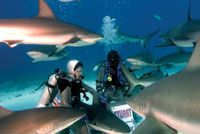Profile of optometrist who swam with sharks
Mark Vogel, OD, spent much of his week-long vacation inside an underwater cage, fulfilling a dream: observing great white sharks.

Dr. Vogel, who started scuba diving in college, said it's just as thrilling for him today-40 years later. Every year, he takes three diving trips to different waters around the world, including the Red Sea and-his favorite-the Caribbean Sea surrounding the Cayman Islands.
But this was the first time Dr. Vogel had been around great white sharks. He recalled seeing six at a time. Each was more than 12 feet long, weighed probably close to 2,000 pounds, and had rows of jagged teeth, some of which were at least 3 inches long.

Upping the ante
After diving for many years in much safer waters, Dr. Vogel decided he was ready for a change and a challenge.
"I always compare diving to skiing," said Dr. Vogel, who practices at the Northport Veterans Administration Medical Center in Northport, NY. "You can't stay on the bunny slope the whole time. You have to advance to the more difficult runs."
So he traveled on a live-aboard ship to Isla Guadalupe, an island 145 miles off the northwest shore of Mexico, where he climbed into an underwater cage attached to the back of a boat. For 3 hours at a time, he observed and photographed the ocean's largest predatory fish.
Up close and personal
"I was impressed with how they seemed so comfortable and so unconcerned about anything," he said. "I got the feeling they knew they were the top dogs in the water. Great whites are very impressive animals."
Still, he wanted more interaction. Several times during his trip, Dr. Vogel was lowered about 40 feet below the surface for 20 minutes at a time in an open cage, which had a top, bottom, four corners, but no bars. Sharks swam up to and around him in the cage. One shark came so close that Dr. Vogel was able to touch its fin.
Sharks are lured to the cage with bait. Wranglers-people experienced at working with sharks-throw chum-mashed fish blood and entrails-into the water. Fish heads are attached to fishing lines and dragged from the boat, all in the hopes of attracting the predators of the deep. Sharks can smell the bait from several miles away. By reeling in the fish heads, shark wranglers can direct sharks either toward divers or away from the cage.
Engaging in this sport has attracted new patients, who are also divers, to Dr. Vogel's practice. Even patients who have never stepped foot in any ocean are intrigued by his underwater experiences.
"This was a little bit of a challenge, and I was able to face it pretty well," said Dr. Vogel. "I have no idea what's next. But this may have been the greatest diving experience of my life."
Newsletter
Want more insights like this? Subscribe to Optometry Times and get clinical pearls and practice tips delivered straight to your inbox.